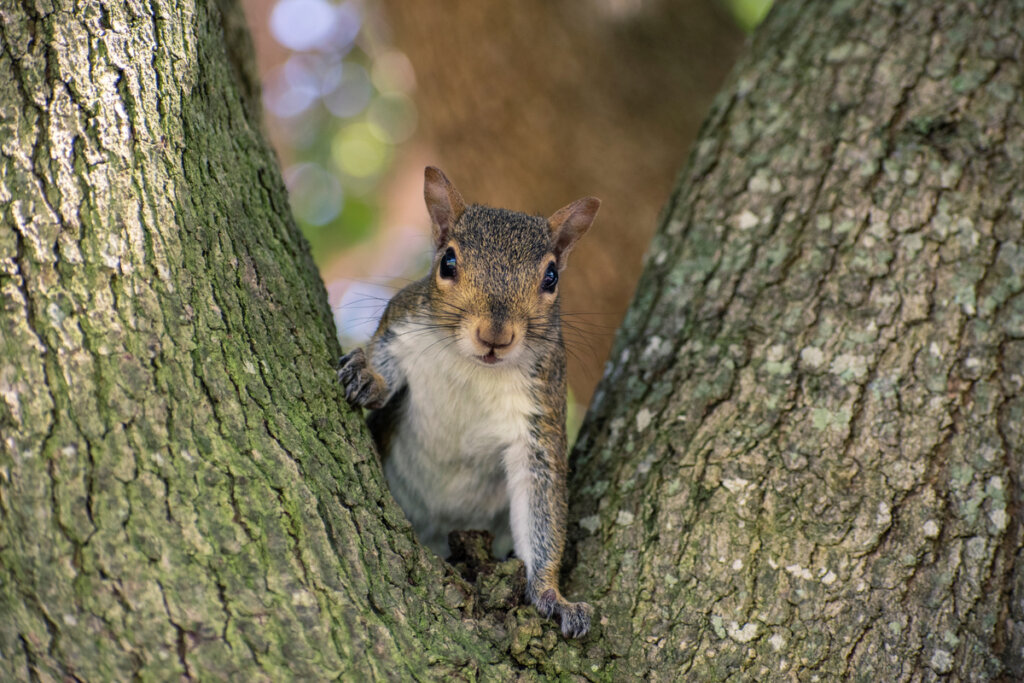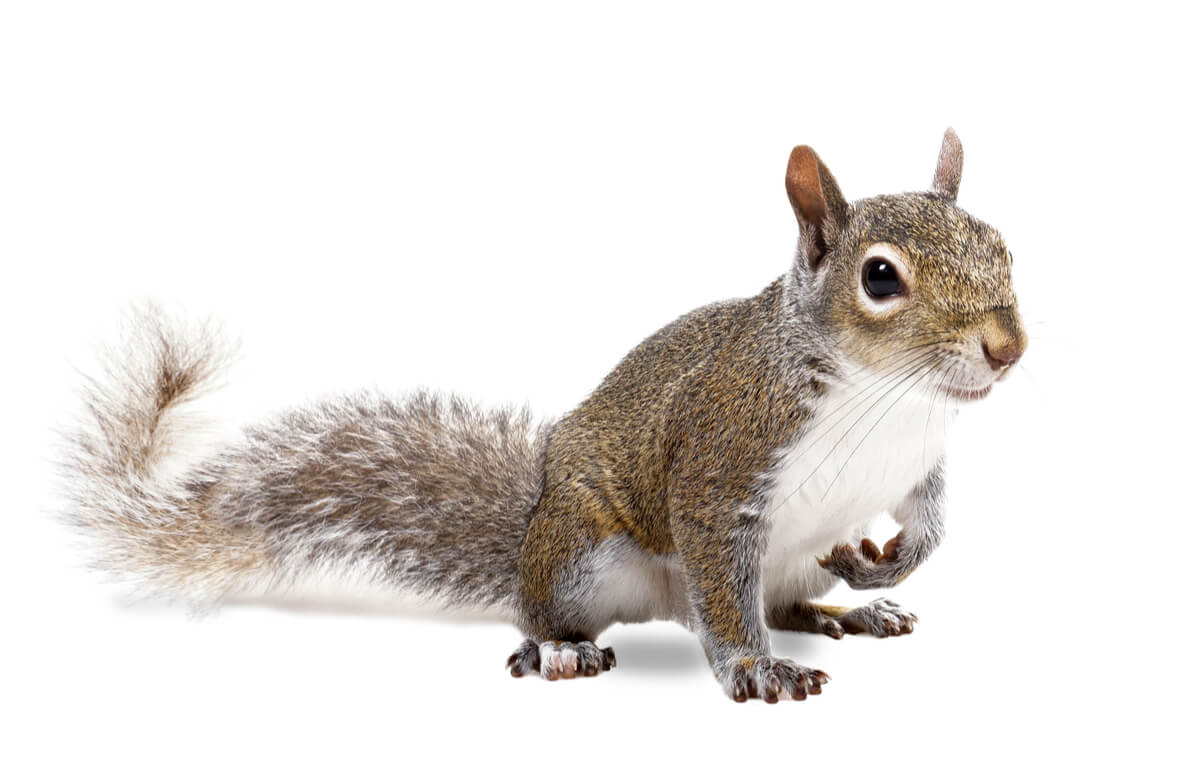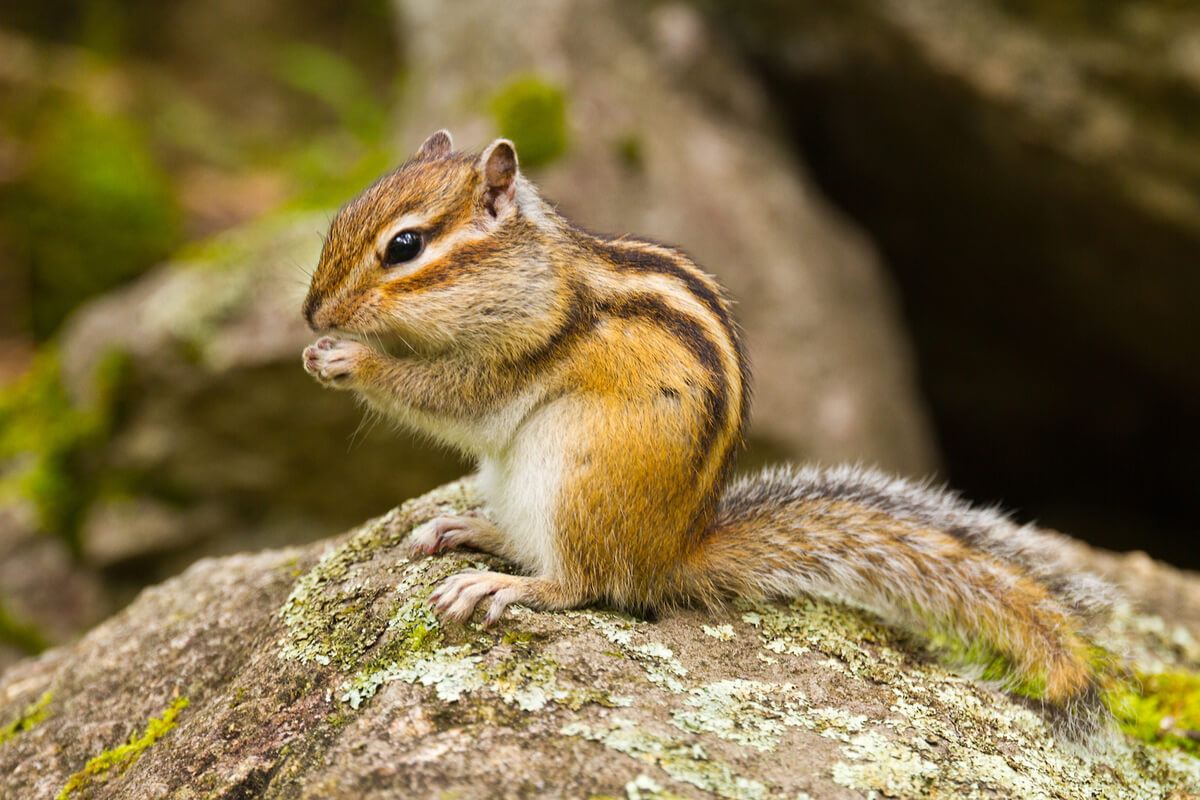9 Curiosities About Squirrels

Squirrels are one of the best-known rodents of all. They belong to the Sciuridae family and are characterized by their rather unique tail and speed. Although they’re quite diverse and you may know a few curiosities about squirrels, we’re sure that we’re going to surprise you with the 9 fascinating facts we’ve come up with!
Squirrels are divided into more than 200 species and three main types: arboreal, terrestrial and flying. These animals are present almost everywhere in the world in any ecosystem with vegetation, except for the continents of Australia and Antarctica. Here are 9 squirrel facts you may not have known.
Curiosities about squirrels
1. Food thieves
One of the best-known characteristics of squirrels is that they’re very good at taking advantage of other people’s food. They spend much of their routine foraging for food at the expense of other squirrels or birds, a behavior known as kleptoparasitism. Their favorite food is dried grains, such as nuts and hazelnuts, although they also consume seeds and fruits.
Tree squirrels are generally diurnal, with some tropical species only coming down to the ground for food. Others, on the other hand, only move among the trees to obtain food.
However, the belief that these rodents only feed on this kind of food is erroneous. Squirrels are omnivorous, so you shouldn’t be surprised if one day you see one eating bird’s eggs, snails, or insects. Another curiosity is that – just like other rodents – squirrels can’t vomit or burp.
To forage for food, these mammals have a powerful olfactory system, which makes it easy for them to find buried nuts. They also rely on their memory and sense of sight to locate where they’re most likely to find food.

2. Different sizes
Although most squirrels seem to be quite small, some species are larger than you would have thought. On one hand, you have the African pygmy squirrel (Myosciurus pumilio), which ranges in size from 7 to 13 centimeters long (between around 3 and 5 inches).
At the other extreme is the Indian giant squirrel (Ratufa indica) which can reach almost 1 meter (3.3 feet) in length, making it the largest squirrel on the planet.
3. Teeth that grow continuously
On the other hand, as far as body parts are concerned, a squirrel’s very distinctive front teeth grow almost 15 centimeters (6 inches) each year. This allows their incisors not to wear down with the incessant gnawing on nuts and other food.
4. Jointed legs
Their hind legs are double-jointed, which makes it easier for them to move between trees. Regardless of gravity, its ankles can rotate 180 degrees, so that its hind legs are backward and cling to the bark of trunks and trees. It’s this mechanism that helps it run quickly up or down.
5. Multipurpose tail
The tail, on the other hand, allows these rodents to take shelter from the rain and cold in winter, thus conserving their body temperature. Like dogs, this limb helps them to balance. Another of our interesting curiosities about squirrels is that they also use their tail to alert other squirrels of danger, wagging it in certain ways to warn about the problem.
6. High intelligence
Another of our curiosities about squirrels is that they learn quite fast compared to other rodents. Several studies have shown that they can adjust their behavior to be more efficient in performing a certain task, such as foraging. Also, it was found in other research that squirrels can deceive animals and other squirrels.
If a squirrel senses that it’s being watched by others, it usually digs a fake hole to mislead them and pretends to deposit food in this place. However, before digging, it stuffs the food into its mouth and subsequently buries it in a different location.
7. In Japan there’s a squirrel garden
These peculiar rodents are so cute that in Japan they have several gardens for them to live peacefully and quietly, as is the case with the Machida Squirrel Park. In fact, tourists can approach and pet them (with the necessary protection) as if they were in a zoo.
8. They transmit diseases
Despite their calm and cuddly appearance, squirrels are also a natural reservoir and a source of infection for various pathologies. Some of the most serious diseases that these animals can transmit are the bubonic plague, tetanus and tularemia.
9. They are born blind
The gestation period of squirrels is 29 to 65 days. After that, the mother breastfeeds and cares for her offspring in her burrow, which can be in hollow trees or in the ground, depending on the species. Like most mammals, with the passage of time the young open their eyes until they have a sharp and focal peripheral vision.
Their range of vision allows squirrels to observe above and to the sides without moving their heads.
Other curiosities about squirrels
Here are some other curiosities about these cute mammals that will surprise and amaze you:
- When a small squirrel is abandoned or lost, a female adopts the offspring into her family.
- Some squirrels can be domesticated without much trouble, although their rodent-like behavior will continue. Watch your cables!
- These rodents may become obese by choice during the winter in order to gain weight and survive during this time.
- Flying squirrels can glide up to 48 meters (around 160 feet), thanks to a muscular membrane found between their legs and body. This structure is called the patagium.

As you have seen, many curiosities about squirrels aren’t too well known. Their ecological value is very broad (thanks to the dispersion of seeds) although, paradoxically, like many other rodents they’re carriers of diseases.
The best recommendation is to visit a veterinarian before adopting or buying a squirrel to learn about its care and breeding. Remember that these animals are very active and require an enormous amount of environmental enrichment, something difficult to achieve in an apartment without a yard.
All cited sources were thoroughly reviewed by our team to ensure their quality, reliability, currency, and validity. The bibliography of this article was considered reliable and of academic or scientific accuracy.
- ¿Cómo encuentran las ardillas nueces enterradas?. Recogido el 9 de marzo de 2021 de: https://respuestas.me/q/co-mo-encuentran-las-ardillas-nueces-enterradas-60411992727
- Portal Oficial de Turismo de Tokyo. (2022). Parque de las Ardillas de Machida. Recogido el 7 de septiembre de 2022 de: https://www.gotokyo.org/es/spot/376/index.html
- Jacobs, L. F., & Liman, E. R. (1991). Grey squirrels remember the locations of buried nuts. Animal Behaviour, 41(1), 103-110.
- Baskaran, N., Venkatesan, S., Mani, J., Srivastava, S. K., & Desai, A. A. (2011). Some aspects of the ecology of the Indian Giant Squirrel Ratufa indica (Erxleben, 1777) in the tropical forests of Mudumalai Wildlife Sanctuary, southern India and their conservation implications. Journal of Threatened Taxa, 3(7), 1899-1908.
